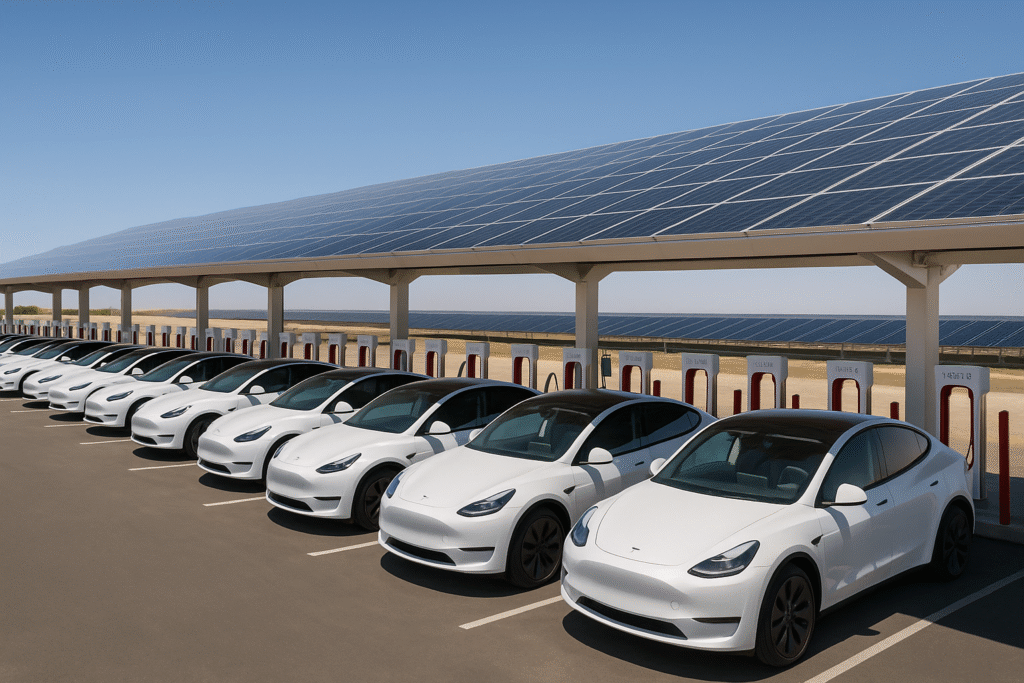Tesla continues to reshape the future of electric mobility with the partial opening of Tesla’s Biggest Supercharger Station in Lost Hills, California. This monumental project marks a significant leap toward sustainable transportation, blending cutting edge solar technology with Tesla’s vast charging infrastructure. Located along the vital Interstate 5, the station promises to be a game changer for EV drivers commuting between San Francisco and Los Angeles one of North America’s busiest electric vehicle corridors.
A Solar Powered Milestone for Tesla’s Biggest Supercharger Station
In October 2024 Tesla broke ground on what would soon become Tesla’s Biggest Supercharger Station, an ambitious project designed to meet the surging demand for EV charging in California. Today, the first phase is officially open, offering 84 fully operational charging stalls powered primarily by solar panels.
The station is part of Tesla’s broader vision to create sustainable, largely off grid charging solutions for its growing fleet of electric vehicles. By leveraging solar power, Tesla is not just expanding its Supercharger network but also reducing its reliance on traditional energy grids a crucial step toward carbon neutral transportation.
Why Tesla’s Biggest Supercharger Station Matters
The significance of Tesla’s Biggest Supercharger Station extends beyond sheer size. With a planned 168 stalls upon full completion later this year, this location will be the largest Supercharger site in the world. For thousands of EV drivers traveling along Interstate 5, it means faster, more reliable charging without long wait times an essential component for mainstream EV adoption.
But what truly sets this project apart is its innovative design. The site operates primarily on solar energy, supported by Tesla’s advanced battery storage systems. Although the project includes a 1.5 megawatt (MW) grid connection, that figure is dwarfed by the clean energy output the solar panels can generate under ideal conditions nearly seven times more.
Building an Oasis for EV Drivers
Dubbed the “Oasis Supercharger” Tesla’s Biggest Supercharger Station is more than just a place to top up your battery. Tesla envisions it as a rest stop and recharge hub where drivers can relax, grab a coffee, or simply take a break while their vehicle powers up.
Given the location’s strategic position between two major Californian cities, the Oasis is expected to handle enormous traffic volumes and Tesla has prepared accordingly. The partially opened site already alleviates the region’s charging congestion, with the remaining 84 stalls set to come online before the end of 2025.
Overcoming Infrastructure Challenges
One of the reasons Tesla chose a solar heavy, off grid approach for Tesla’s Biggest Supercharger Station is due to delays in local substation upgrades. With California’s EV adoption accelerating rapidly, waiting for traditional infrastructure expansion wasn’t an option.
Instead! Tesla leaned into its strengths: renewable energy and self sufficiency. The solar arrays installed at the Lost Hills location not only provide ample energy for charging but also act as a real world demonstration of how renewable power can fuel large scale infrastructure projects.
This bold approach reflects Tesla’s long term commitment to reducing carbon emissions and reshaping energy consumption patterns not just for cars, but for communities as a whole.
What This Means for the Future
The successful partial opening of Tesla’s Biggest Supercharger Station is a clear signal of where the EV industry is headed. Rapid charging, energy independence, and sustainable infrastructure are no longer future ambitions they are happening now.
As more stations like Lost Hills come online, Tesla is addressing two of the biggest concerns holding back EV adoption range anxiety and charging availability. More importantly, it’s proving that renewable energy can meet the high demands of modern transportation networks.
Industry experts believe the Oasis Supercharger could serve as a blueprint for future EV hubs worldwide. By integrating solar energy, battery storage, and high-speed charging, Tesla is setting new standards that others may soon follow.
With Tesla’s Biggest Supercharger Station partially operational and fully solar powered, the future of sustainable travel looks brighter than ever. Tesla’s bold vision is becoming reality, one charging station at a time, and Lost Hills stands as a testament to what is possible when technology, sustainability, and ambition come together.
As we move closer to 2025, all eyes will be on Tesla to see how quickly the remaining 84 stalls are completed and how this project continues to revolutionize the EV experience. One thing is certain with initiatives like these Tesla isn’t just building charging stations; they are building the future.

